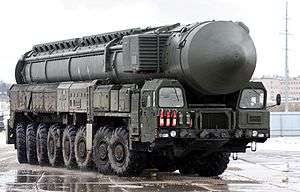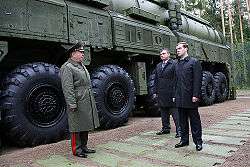RT-2PM2 Topol-M
The RT-2PM2 «Topol-M» (Russian: РТ-2ПМ2 «Тополь-М», NATO reporting name: SS-27 "Sickle B"[5], other designations: SS-27 Mod 1,[6][7] RS-12M1, RS-12M2, formerly incorrectly RT-2UTTKh)[8] is one of the most recent intercontinental ballistic missiles to be deployed by Russia (see RS-24), and the first to be developed after the dissolution of the Soviet Union. It was developed from the RT-2PM Topol mobile intercontinental ballistic missile.
| Topol-M SS-27 "Sickle B" | |
|---|---|
 A Topol-M (in its container) on MZKT-79221 mobile launcher during rehearsals for the 2012 Moscow Victory Day Parade. | |
| Type | Intercontinental ballistic missile |
| Place of origin | Russia |
| Service history | |
| In service | December 1997–present |
| Used by | Russian Strategic Missile Troops |
| Production history | |
| Designer | Moscow Institute of Thermal Technology |
| Manufacturer | Votkinsk Machine Building Plant |
| Produced | December 1994–2010 |
| Specifications | |
| Mass | 47,200 kg (104,000 lb) |
| Length | 22.7 m (74.47 ft) |
| Diameter | 1.9 m (6 ft 3 in) |
| Warhead | 1 Mt warhead[1] |
| Engine | Three-stage Solid-fuel rocket |
Operational range | 11,000 km (6,800 mi)[2] |
| Maximum speed | 7,320 metres per second (26,400 km/h; 16,400 mph; Mach 22)[3] |
Guidance system | Inertial with GLONASS[4] |
| Accuracy | 200 m CEP[3] |
Launch platform | Silo, road-mobile TEL |
In its Russian designation РТ stands for "ракета твердотопливная", raketa tverdotoplivnaya ("solid fuel rocket"), while УТТХ – for "улучшенные тактико-технические характеристики," uluchshenniye taktiko-tekhnicheskie kharakteristiki ("improved tactical and technical characteristics"). "Topol" (тополь) in Russian means "white poplar". It is designed and produced exclusively by the Moscow Institute of Thermal Technology, and built at the Votkinsk Machine Building Plant.[9][10]
Characteristics
The Topol-M is a cold-launched, three-stage, solid-propellant, silo-based or road-mobile intercontinental ballistic missile.[2] The missile's length is 22.7 m and the first stage has a body diameter of 1.9 m. The mass at launch is 47,200 kg, including the 1,200 kg payload. Topol-M carries a single warhead with an 800 kt yield[1] but the design is compatible with MIRV warheads. According to chief designer Yury Solomonov, the missile can carry four to six warheads along with decoys.[11] Its minimum range is estimated to be 2,000 km and the maximum range 10,500 km. It has three solid rocket stages with inertial, autonomous flight control utilizing an onboard GLONASS receiver.[12] It is reputed to have the highest accuracy of any Russian ICBM[13] with a CEP of 200m.[14] The body of the rocket is made by winding carbon fiber.
The Topol-M may be deployed either inside a reinforced missile silo or from an APU launcher mounted on the MZKT-79221 "Universal" 16-wheeled transporter-erector-launcher.[13] This mobile launcher is capable of moving through roadless terrain, and launching a missile from any point along its route. The designation for the silo-based Topol-M missile is believed to be RS-12M2, while the mobile version is RS-12M1.[8]

The first stage has rocket motors developed by the Soyuz Federal Center for Dual-Use Technologies. These give the missile a much higher acceleration than other ICBM types. They enable the missile to accelerate to the speed of 7,320 m/s and to travel a flatter trajectory to distances of up to 10,000 km.[3]
As a solid propellant design, the missile can be maintained on alert for prolonged periods of time and can launch within minutes of being given the order.[11]
Development and deployment
The development of the missile began in the late 1980s as a response to the American Strategic Defense Initiative.[15] Initially an evolutionary upgrade of the RT-2PM Topol,[16] the missile was redesigned in 1992. The missile's principal designer was Yuri Solomonov, who would later oversee the development of the RSM-56 Bulava.[17]
The first flight test took place on December 20, 1994, during which the missile, launched from Plesetsk, hit its target 4,000 miles (6,400 km) away.[18][19] Two missiles were put on experimental combat duty in December 1997 at Tatishchevo.[18] The fifth test flight on 22 October 1998 was unsuccessful as the missile exploded after being launched; the sixth test flight two months later was successful.[18] The 104th Regiment of the Taman Missile Division, based in Saratov, introduced 10 missiles into service on 30 December 1998; another ten entered service with a second regiment in December 1999.[18][20]
Silo launcher Topol-M entered service by presidential decree on 13 July 2000, the third, fourth and fifth regiments entered service in 2000, 2003 and 2005. The last regiment was to arrive in 2012.[21]
On December 12, 2006 the first three mobile Topol-M missile systems entered duty with a missile unit stationed near the town of Teykovo.[22]
By the end of 2010 the Russian Strategic Missile Troops operated 70 Topol-M missile systems including 52 silo-based and 18 mobile systems. A further 8 missiles were to join the Forces by 2011–2012.[23]
Current Strategic Rocket Forces Order of Battle lists the following sites with Topol-M missiles:[23][24]
- 27th Guards Rocket Army (HQ: Vladimir)
- 60th Missile Division at Tatishchevo with 60 silo-based Topol-M
- 54th Guards Missile Division at Teykovo with 18 mobile Topol-M
The Topol-M missiles have a lifetime between 15 and 20 years.
Missile defense evasion capabilities
According to Russia the missile and its various versions, RS-24 Yars (SS-27 Mod 2), RS-26 Rubezh (another SS-27 version) and RSM-56 Bulava (SLBM version of SS-27) are designed to counter and evade current or planned United States missile defense system.[25] It is said to be capable of making evasive maneuvers to avoid a kill by interceptors, and carries targeting countermeasures and decoys.[26]
One of the Topol-M's most notable features is its short engine burn time following take-off, intended to minimize satellite detection of launches and thereby complicate both early warning and interception by missile defense systems during boost phase. The missile also has a relatively flat ballistic trajectory, complicating defense acquisition and interception.[27]
According to The Washington Times, Russia has conducted a successful test of the evasive payload delivery system.[28] The missile was launched on 1 November 2005 from the Kapustin Yar facility. The warhead changed course after separating from the launcher, making it difficult to predict a re-entry trajectory.
Equipment of Topol-M with MIRV
A new missile loosely based on Topol-M and equipped with multiple re-entry vehicles (MIRV) is called RS-24 Yars. In January 2009 Russian sources hinted that the production of the mobile Topol-M missile would be shutting down in 2009 and that the new MIRVed RS-24 version would replace it.[29]
Operators
The Strategic Missile Troops are the only operator of the RT-2PM2 Topol-M. As of March 2020[30], 60 silo-based and 18 mobile RT-2PM2 Topol-M missiles are deployed with 2 rocket divisions:
Silo-based:
- 60th Rocket Division at Tatishchevo Air Base
Road-mobile:
It is believed that since 2010 no more RT-2PM2 Topol-M missiles have been purchased in favor of the newest RS-24 Yars.
See also
- Strategic Missile Troops
- RT-2PM Topol
- RS-24 Yars
- RS-26 Rubezh
- RS-28 Sarmat
- R-36 (missile)
- UR-100N
- LGM-30 Minuteman
- DF-5
- DF-31
- DF-41
References
- http://www.sipri.org/yearbook/2011/files/SIPRIYB1107-07A.pdf
- "SS-25 (RS-12M Topol) - Missile Threat".
- "Topol-M: Missile Defense Penetrator by Michal Fiszer". Mputtre.com. Archived from the original on 2012-12-30. Retrieved 2011-05-23.
- www.missiledefenseadvocacy.org. "Missile Defense Advocacy Alliance » SS-27 / Topol-M". missiledefenseadvocacy.org.
- "SS-27 Sickle B". Deagel.com. 2011-03-10. Retrieved 2011-05-23.
- https://fas.org/blogs/security/2014/05/russianmodernization/
- "Crowdsourcing Russian ICBMs". www.armscontrolwonk.com.
- RS-12M1/2 Topol-M (SS-27/RT-2PM2) (Russian Federation), Offensive weapons
- "RT-2PMU? – Topol-M SS-27 – Russian / Soviet Nuclear Forces". Fas.org. Retrieved 2011-05-23.
- Land-Based Ballistic Missiles
- "Archived copy". Archived from the original on 2016-11-04. Retrieved 2016-11-03.CS1 maint: archived copy as title (link)
- "Russia to re-equip its new mobile ICBMs with multiple warheads". RIA Novosti. 2006-12-15. Retrieved 2011-05-23.
- "Russia". Nti.org. Retrieved 2011-05-23.
- "Topol-M / RS-12M2, RT-2PM2, SS-27 Sickle B, SS-X-27". Deagel.com. 2011-03-10. Retrieved 2011-05-23.
- Bleek, Philipp C. (1 June 2000). "Russia Approves Topol-M, Warns Missile Could Defeat U.S. Defense". Arms Control Today. 30 (5): 26. Retrieved 5 May 2015 – via Questia Online Library.
- "Defense & Security Intelligence & Analysis: IHS Jane's | IHS". Archived from the original on September 4, 2012. Retrieved October 22, 2008.
- Champlin, Luke (October 2009). "Russia Defends Struggling Missile Program". Arms Control Today. 39 (8): 45. Retrieved 23 May 2015 – via Questia.
- Norris, Robert S.; Arkin, William M. (1 July 2000). "Russian Nuclear Forces, 2000". Bulletin of the Atomic Scientists. Archived from the original on 24 September 2015. Retrieved 15 May 2015 – via HighBeam Research.
- "Russia tested a prototype for a new intercontinental ballistic missile successfully". Defense Daily. 22 December 1994. Archived from the original on 24 September 2015. Retrieved 15 May 2015 – via HighBeam Research.
- Hoffman, David (27 December 1998). "Russia Set To Deploy Topol-M Missiles; Move Comes Amid Dispute on Control". Washington Post. Archived from the original on 8 January 2016. Retrieved 15 May 2015 – via HighBeam Research.
- ""Тополь-М": история создания и перспективы - Ракетная техника". rbase.new-factoria.ru.
- Strategic Missile Forces spokesman Col. Alexander Vovk, quoted by ITAR TASS.
- "Russia adds 2 Topol-M ballistic missiles to nuclear deterrent". RIA Novosti. 2010-12-17. Retrieved 2011-05-23.
- Strategic Rocket Forces (2007-12-13). "Strategic Rocket Forces – Russian strategic nuclear forces". Russian Strategic Nuclear Forces. Retrieved 2011-05-23.
- "General says Russia will counter U.S. missile defense plans". USA Today. 2008-05-27. Retrieved 2011-05-23.
- Confidencial Digital (11 March 2014). "Así es el Topol-M, el misil ruso que burla el Escudo Antimisiles" – via YouTube.
- "Russia Approves Topol-M; Warns Missile Could Defeat U.S. Defense". Armscontrol.org. June 2000. Retrieved 2011-05-23.
- Washington, The (2005-11-20). "Russian warhead alters course midflight in test". Washington Times. Retrieved 2011-05-23.
- Армс-Тасс (2009-01-22). Армс-Тасс (in Russian). Arms-tass.su. Archived from the original on October 3, 2011. Retrieved 2011-05-23.
- Kristensen, Hans M.; Korda, Matt (9 March 2020). "Russian nuclear forces, 2020". Bulletin of the Atomic Scientists. 76 (2): 73–84. doi:10.1080/00963402.2020.1728985.
External links
| Wikimedia Commons has media related to RT-2PM2 Topol-M. |